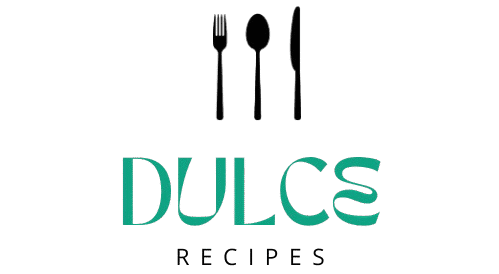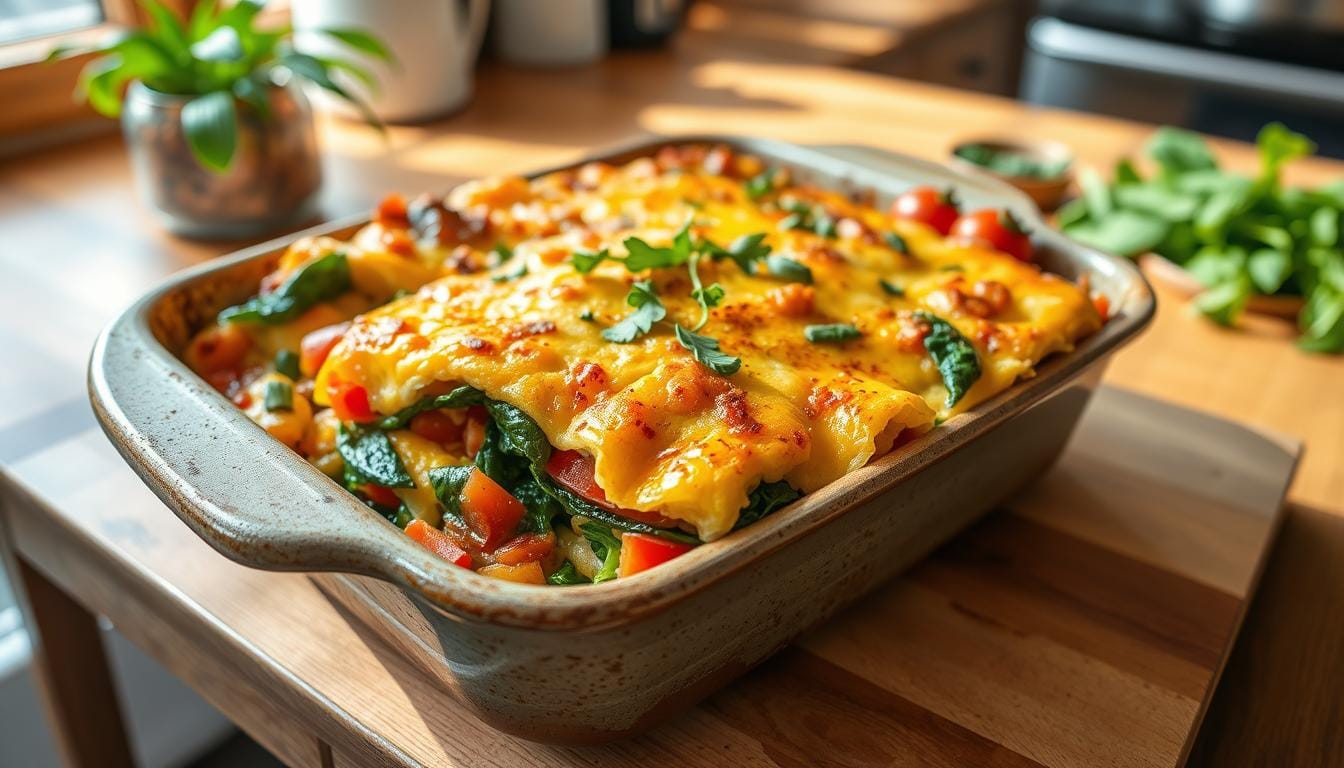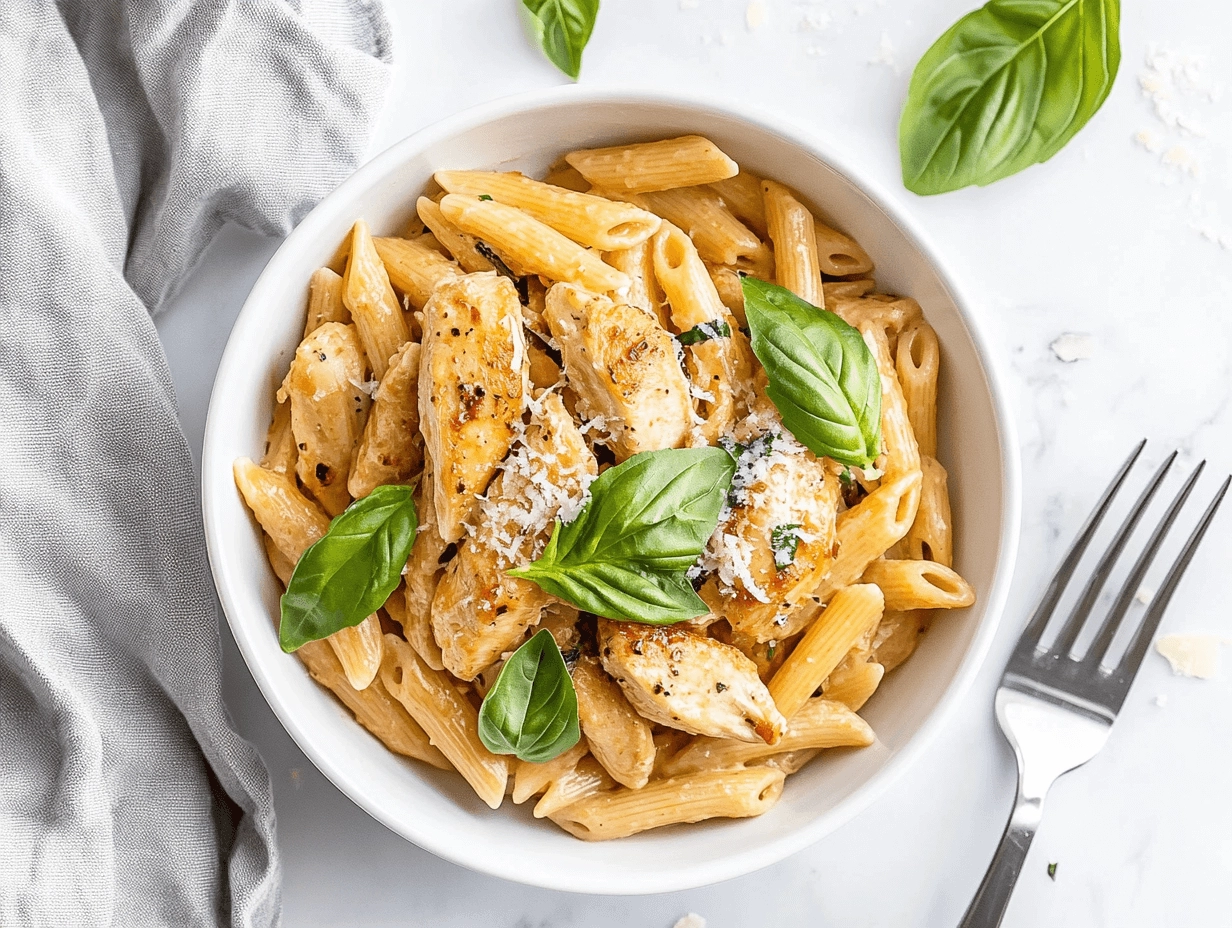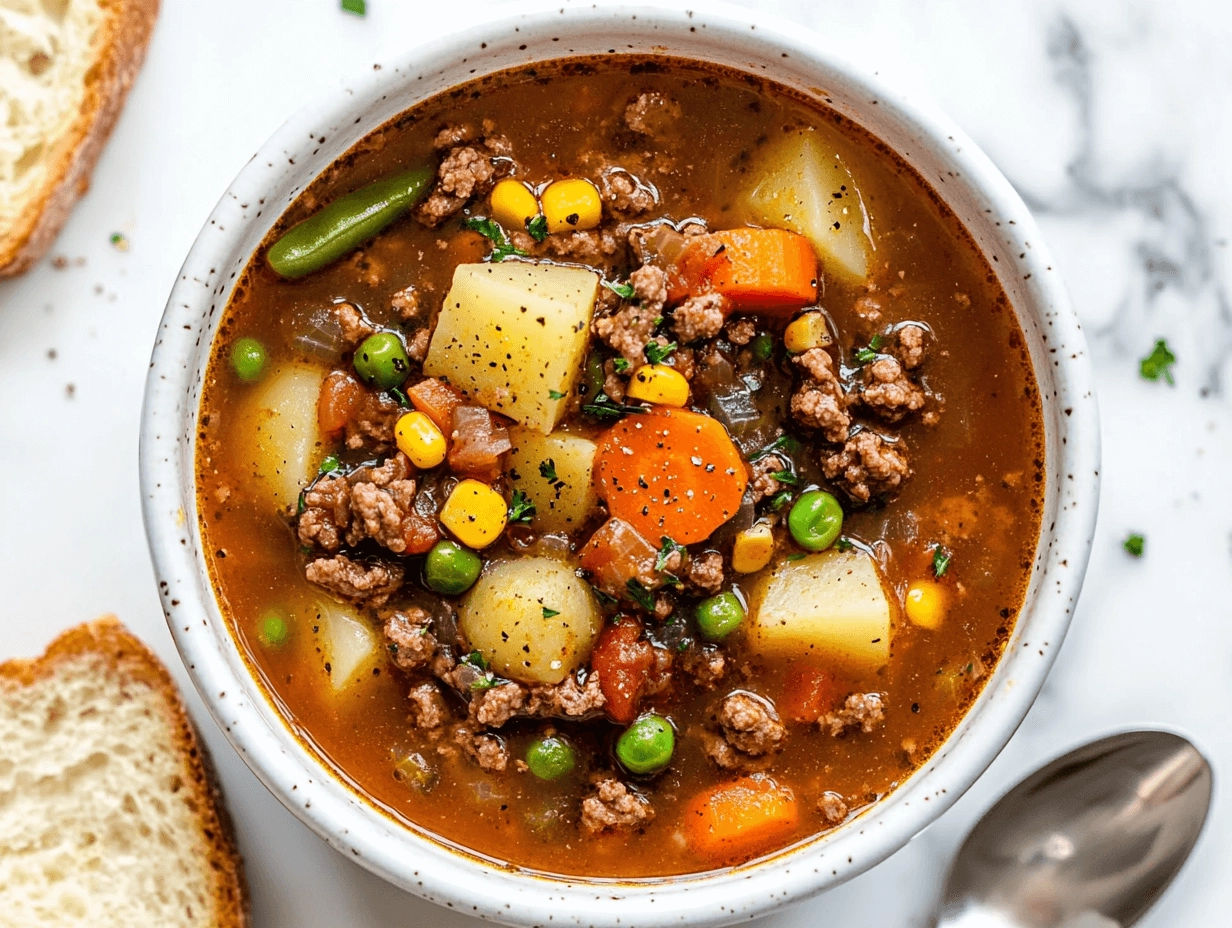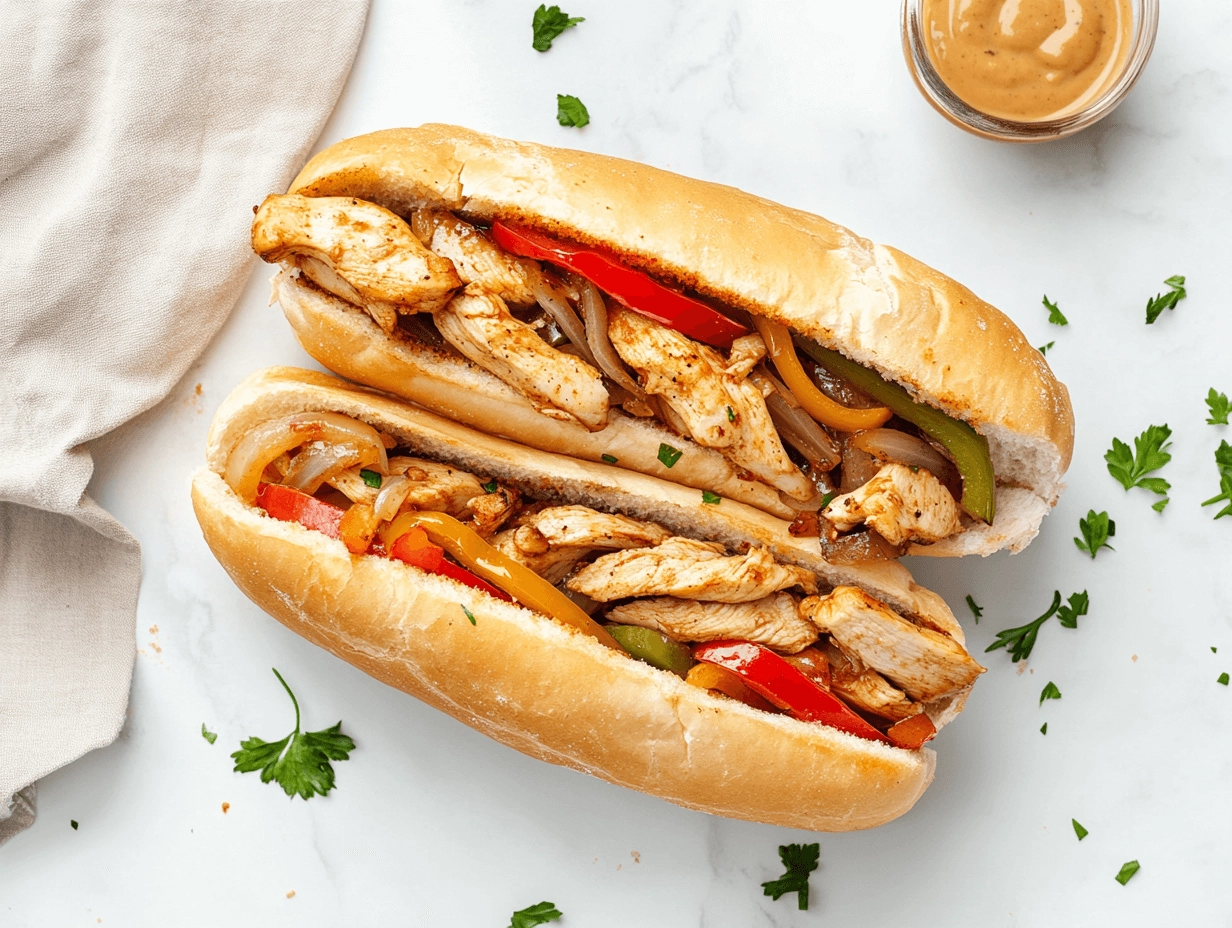Every Sunday morning, my kitchen turns into a place of sizzling sounds and warm smells. I’ve found gluten-free breakfast casserole recipes that are both filling and healthy. These dishes are my go-to for making tasty, nutritious meals for everyone.
Gluten-free breakfast casseroles are more than just food. They’re perfect for busy mornings, special diets, and family meals. If you have celiac disease, gluten sensitivity, or just want a healthier start, these recipes are for you.
In this guide, we’ll look at five amazing healthy breakfast casserole ideas. They show that gluten-free meals can be tasty and fulfilling. From dishes full of protein to ones loaded with veggies, these recipes will change how you start your day.
Table of Contents
Discover more delicious recipes and ideas by visiting our homepage!
Understanding Gluten Free Breakfast Casseroles
Exploring gluten-free brunch recipes opens up a world of delicious possibilities for those with dietary restrictions. A breakfast casserole without gluten can be a game-changer for individuals seeking tasty and nutritious morning meals.
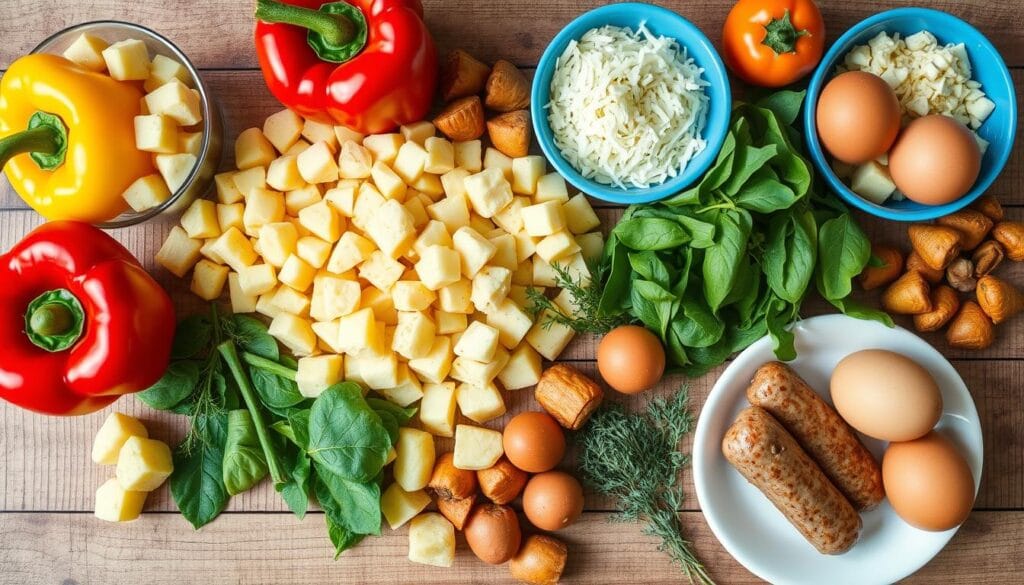
Benefits of Making Gluten-Free Casseroles
Gluten-free breakfast casseroles offer numerous advantages for health-conscious eaters. These dishes provide essential benefits:
- Safe for individuals with celiac disease
- Supports digestive health
- Reduces inflammation
- Allows for creative ingredient combinations
Essential Ingredients for Success
Creating the perfect egg casserole without gluten requires careful ingredient selection. Key components include:
| Ingredient Category | Recommended Options |
|---|---|
| Protein | Eggs, sausage, bacon, turkey |
| Vegetables | Spinach, bell peppers, onions |
| Starch Alternatives | Gluten-free hash browns, potato chunks |
| Cheese | Cheddar, Monterey Jack (check for gluten-free) |
Common Substitutions and Alternatives
Navigating gluten-free brunch recipes becomes easier with smart ingredient swaps. Creativity is key when developing delicious alternatives:
- Replace wheat bread with gluten-free bread or potato bases
- Use cornstarch instead of wheat flour for thickening
- Select certified gluten-free cheese and dairy products
- Experiment with alternative grain-free flour blends
By understanding these principles, you can craft mouthwatering breakfast casseroles that everyone can enjoy, regardless of dietary restrictions.
Must-Have Kitchen Tools for Perfect Breakfast Casseroles
To make tasty brunch potluck casseroles, you need more than just good ingredients. You also need the right kitchen tools. Having the right tools is key to making a delicious breakfast casserole.
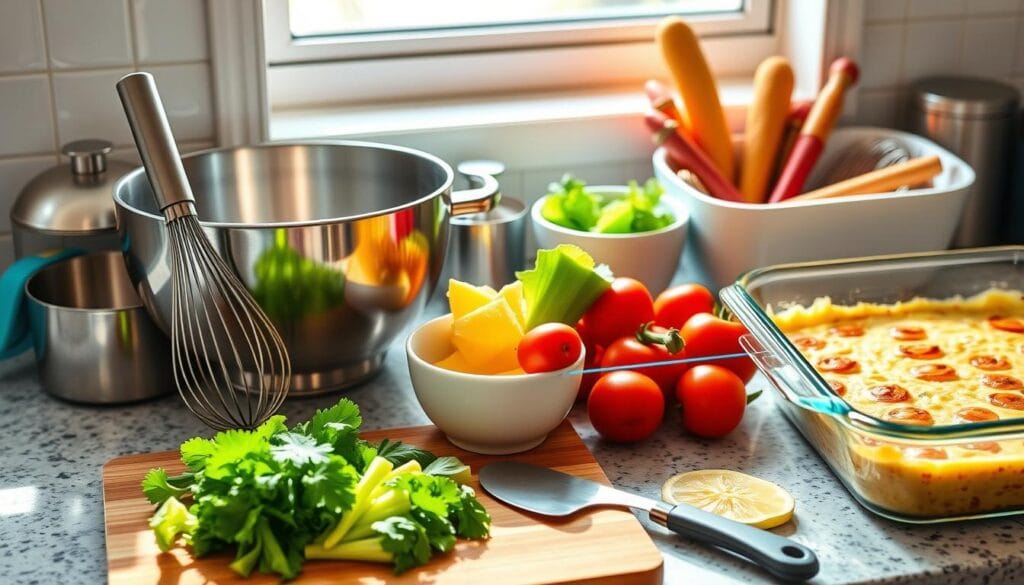
- 9×13-inch Baking Dish: The cornerstone of any great casserole, providing ideal space for layering ingredients
- Large Mixing Bowls: For combining ingredients thoroughly
- Whisk: Ensures smooth egg mixtures and proper ingredient integration
- Sharp Chef’s Knife: For precise ingredient preparation
- Cutting Board: Provides a clean surface for chopping vegetables and meats
When making brunch potluck casseroles, choose high-quality, durable tools. Ceramic or glass baking dishes are best for even heat. Heavy-duty mixing bowls are great for whisking and won’t slip.
| Tool | Purpose | Recommended Material |
|---|---|---|
| Baking Dish | Even cooking and serving | Ceramic or Pyrex |
| Mixing Bowls | Ingredient preparation | Stainless Steel or Glass |
| Whisk | Blending eggs and ingredients | Stainless Steel |
Professional chefs say having special tools for breakfast casseroles is a must. With the right tools, your kitchen will become a workshop for breakfast wonders. You’ll be ready to wow at any brunch potluck.
Classic Sausage and Hash Brown Breakfast Casserole
Discover the ultimate make-ahead breakfast dish that will transform your morning routine. This classic sausage and hash brown breakfast casserole brings together hearty ingredients and simple preparation. It creates a crowd-pleasing meal that everyone will love.
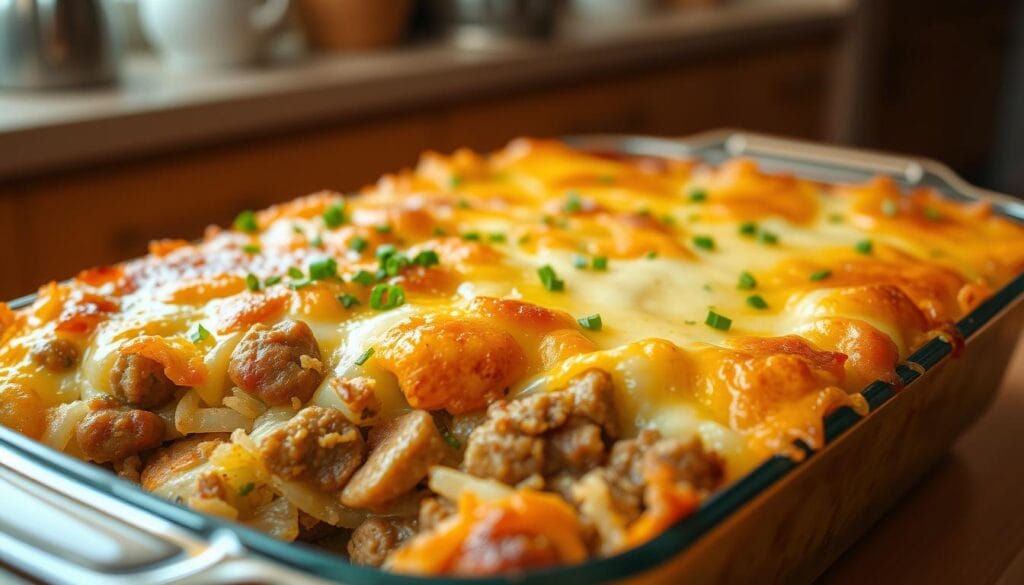
Key Ingredients and Measurements
To create this delicious breakfast masterpiece, you’ll need the following ingredients:
- 1 pound ground pork sausage
- 4 cups frozen hash browns
- 12 large eggs
- 2/3 cup half-and-half
- 1 cup shredded cheddar cheese
- 3/4 cup chopped yellow onion
- 2 cups chopped bell peppers
Step-by-Step Preparation Guide
Creating this breakfast casserole is easier than you might think. Here’s a simple method to ensure perfect results:
- Brown the sausage in a skillet
- Layer hash browns in a greased baking dish
- Spread cooked sausage over hash browns
- Whisk eggs with half-and-half and seasonings
- Pour egg mixture over sausage and hash browns
- Top with cheese
Storage and Reheating Tips
Why do you have to refrigerate breakfast casserole overnight? Refrigeration allows flavors to meld and helps the bread and eggs absorb liquid. This creates a more cohesive dish. Prepare your casserole the night before, cover it, and let it rest in the refrigerator for at least 30 minutes or up to 24 hours.
| Storage Method | Duration |
|---|---|
| Refrigerator (prepared) | Up to 5 days |
| Freezer (unbaked) | Up to 3 months |
| Baking Temperature | 375°F (191°C) |
| Baking Time | 40-45 minutes |
When reheating, cover the casserole with foil and warm in the oven at 350°F for about 15-20 minutes until heated through. Your make-ahead breakfast dish will taste just as delicious as when it was first prepared!
Turkey Spinach Artichoke Morning Bake
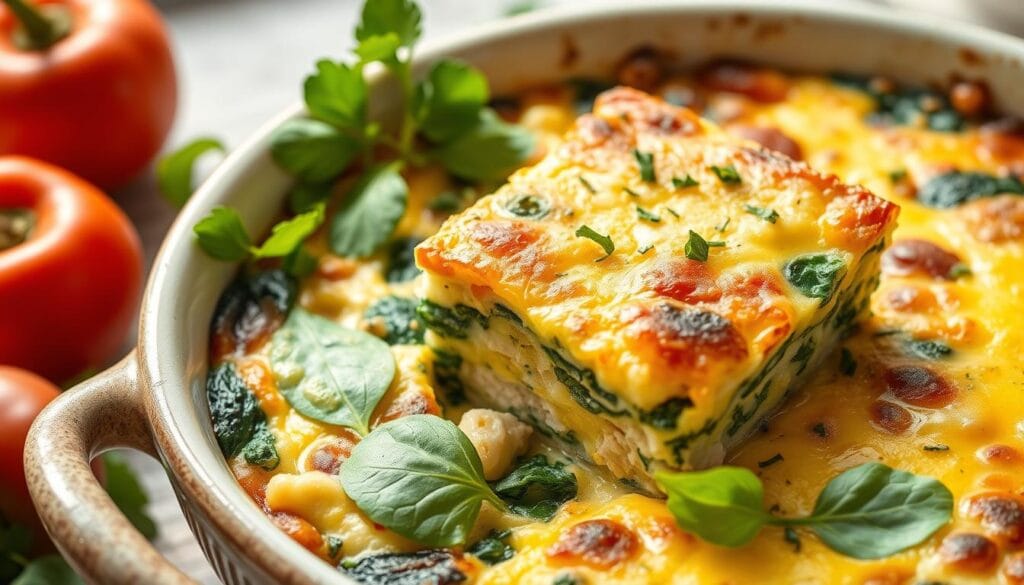
Try this tasty turkey spinach artichoke morning bake for a healthy breakfast. It’s packed with lean protein and fresh veggies for a great start to your day.
Lean turkey is a top choice for healthy breakfast casseroles. This recipe mixes tender turkey, spinach, and artichokes for a nutritional boost.
Key Nutritional Highlights:
- Total Servings: 6
- Calories per Serving: 264
- Protein per Serving: 17g
- Carbohydrates per Serving: 5g
This recipe uses simple ingredients for a delicious, healthy breakfast. Fresh spinach and artichoke hearts add vitamins and minerals. Ground turkey provides lean protein for energy.
Ingredient Recommendations:
- 1 lb ground turkey
- 5 oz fresh spinach
- 1 cup artichoke hearts
- 7 large eggs
- 16 oz cottage cheese
- 1½ cups shredded cheddar
Customize your breakfast casserole with different greens or chicken sausage. It’s great for up to a week in the fridge, making prep easy.
Baking Details:
- Temperature: 350°F
- Baking Time: 45 minutes
- Storage: Refrigerate up to 7 days
This turkey spinach artichoke morning bake is a tasty, healthy start to your day. It’s packed with protein!
Gluten Free Breakfast Casserole Recipes
Making gluten free breakfast casseroles is simpler than you think. These dishes are both nutritious and filling. They can be tailored to fit any taste.
Base Recipe Components
Every gluten free breakfast casserole needs a few key ingredients. These include:
- Eggs (10 large eggs recommended)
- Gluten-free milk or dairy alternative
- Cheese (2 cups of grated cheese works best)
- Protein source (sausage, turkey, or vegetarian alternatives)
- Seasonings and herbs
Customization Options
Gluten free breakfast casseroles offer endless ways to get creative. You can add:
- Vegetables (spinach, bell peppers, mushrooms)
- Different protein choices
- Gluten-free bread or potato alternatives
- Unique cheese blends
Serving Suggestions
Looking for something to go with your breakfast casserole? Try these:
| Side Dish | Complementary Flavor |
|---|---|
| Fresh fruit salad | Light and refreshing |
| Gluten-free toast | Additional texture |
| Greek yogurt | Protein boost |
| Herbal tea | Warm beverage pairing |
Pro tip: Most gluten free breakfast casseroles can be made ahead. Store them in the fridge for up to 4 days or freeze for 3 months. This makes meal prep easy.
Make-Ahead Tips and Meal Prep Strategies
Getting ready for breakfast can be easy and stress-free. Gluten-free breakfast casseroles are great for families who want healthy meals without hassle. With a little planning, you can make tasty breakfasts that save you time and effort.
Learning to make breakfast ahead of time is all about smart planning. Here are some key tips to help you plan your meals better:
- Assemble casseroles the night before baking
- Use airtight containers for storage
- Portion and freeze individual servings
- Label containers with preparation dates
Keeping your casserole fresh is important. Most gluten-free breakfast casseroles can be stored safely for up to 5 days. Here are some tips for keeping your casserole fresh:
- Cool casserole completely before refrigerating
- Cover tightly with plastic wrap or lid
- Store in the coldest part of your refrigerator
- Reheat at 350°F for 15-20 minutes
Freezing is another great way to prepare breakfast ahead of time. Unbaked casseroles can be frozen for up to 3 months. Just wrap them in freezer-safe containers, thaw overnight, and bake as usual.
With these strategies, meal prep becomes a breeze. Your future self will appreciate the delicious, hassle-free breakfasts waiting for you.
Dairy-Free and Vegan Variations
Creating delicious dairy-free breakfast bakes and vegan breakfast casseroles opens up a world of culinary possibilities for those with dietary restrictions. These adaptable recipes ensure everyone can enjoy a hearty morning meal packed with nutrition and flavor.
Plant-Based Protein Powerhouses
Transforming traditional breakfast casseroles into vegan-friendly meals requires innovative protein sources. Tofu, chickpeas, and tempeh stand out as excellent alternatives to eggs and meat.
- Tofu: Provides 9g of protein per serving
- Chickpea flour: Adds protein and creates a creamy texture
- Lentils: Excellent protein-rich base for vegan casseroles
Egg Substitutes for Vegan Versions
Finding the right egg replacement is key for dairy-free breakfast bakes. Several options can help you achieve the desired texture and binding properties.
| Egg Substitute | Protein Content | Best Used For |
|---|---|---|
| Silken Tofu | 9g per serving | Creamy casseroles |
| Chickpea Flour | 6g per 1/4 cup | Binding and texture |
| Flax Seeds | 3g per tablespoon | Light, fluffy texture |
When preparing vegan breakfast casseroles, experiment with different plant-based milk alternatives like almond, oat, or soy milk. These options provide creaminess while keeping the dish completely dairy-free.
Pro tip: Use nutritional yeast to add a cheesy flavor to your vegan breakfast bakes without dairy. This ingredient provides additional protein and a rich, savory taste that mimics traditional cheese.
Nutritional Benefits and Dietary Considerations
Healthy breakfast casseroles are more than tasty. They are packed with nutrients that boost your health and meet your dietary needs.
Knowing what’s in your breakfast casserole is key. It helps you make better food choices. Here’s why these casseroles are great for breakfast:
- Protein Powerhouse: Each serving provides 14-27 grams of protein
- Calorie Range: Approximately 322-477 calories per serving
- Balanced Macronutrients: 14-19 grams of carbohydrates
- Healthy Fats: 23-34 grams of fat per serving
You can adjust your breakfast casserole to fit your diet. Whether you’re on a low-carb, keto, or high-protein diet, these dishes can be tailored to your needs.
| Nutritional Aspect | Value per Serving |
|---|---|
| Protein | 14-27g |
| Calories | 322-477 |
| Carbohydrates | 14-19g |
| Total Fat | 23-34g |
To get the most nutrition, add ingredients like sweet potatoes. They’re full of vitamins A and C, which help your immune system. Adding veggies boosts the dish’s nutritional value, making it both tasty and healthy.
Pro tip: Preparing these casseroles ahead of time lets you control what goes in. This way, you can start your day with a meal that’s both balanced and nutritious.
Seasonal Variations and Holiday Adaptations
Make your gluten-free brunch recipes festive by using seasonal ingredients. Each season offers unique flavors and produce. These can turn your breakfast casseroles into unforgettable meals.
Seasonal ingredients can really boost your gluten-free brunch recipes. Here are some exciting variations:
- Spring: Asparagus, fresh herbs, and light goat cheese
- Summer: Colorful bell peppers, zucchini, and fresh corn
- Autumn: Roasted butternut squash, sage, and caramelized onions
- Winter: Hearty kale, roasted chestnuts, and cranberries
Holiday gatherings need gluten-free brunch recipes that feed many. Your casserole can serve 8-12 people with smart preparation.
| Holiday | Recommended Casserole Adaptation | Serving Size |
|---|---|---|
| Christmas | Ham and Herb Potato Casserole | 10-12 servings |
| Thanksgiving | Turkey and Sage Breakfast Bake | 8-10 servings |
| Easter | Spring Vegetable and Herb Casserole | 8-12 servings |
When making gluten-free brunch recipes for holidays, prep ingredients early. This helps reduce stress. It also lets you enjoy time with guests while serving a delicious meal.
Tips for Preventing Common Casserole Issues
Making the perfect breakfast casserole takes skill and attention. Many struggle with common problems that can ruin a dish. Knowing how to avoid these issues will help you get it right.
Solving the Watery Casserole Dilemma
Ever wondered why your breakfast casserole is watery? Several things can make it too wet. It’s all about managing moisture for the right texture.
- Drain vegetables well before adding them to the casserole
- Use paper towels to soak up water from ingredients like spinach or zucchini
- Avoid overbeating eggs to prevent adding too much moisture
- Choose low-moisture cheeses and proteins
Understanding Casserole vs. Frittata Distinctions
What’s the difference between a breakfast casserole and a frittata? Both are egg-based, but they’re made differently. Casseroles are baked in a dish, while frittatas start on the stovetop and finish in the oven.
| Characteristic | Breakfast Casserole | Frittata |
|---|---|---|
| Cooking Method | Fully baked in oven | Started on stovetop, finished in oven |
| Typical Pan | Deep baking dish | Oven-safe skillet |
| Texture | Layered, dense | Open-faced, lighter |
Perfect Texture Guidelines
Getting the right texture is all about technique. Use fresh ingredients, manage moisture, and follow recipes closely. A great casserole is firm but not dry, with creamy inside and crisp edges.
By following these tips, you’ll make breakfast casseroles that are always tasty and well-made.
Conclusion
Exploring gluten-free breakfast casserole recipes opens up a world of delicious and nutritious morning meals. Nearly 3 million people in the United States follow a gluten-free diet. These recipes offer something special for everyone.
You’ve seen how versatile and satisfying gluten-free breakfast casseroles can be. From classic sausage bakes to innovative plant-based alternatives, there’s something for everyone.
The key takeaway is that dietary restrictions don’t mean you have to give up flavor or nutrition. Gluten-free breakfast casserole recipes are a great solution for busy families and health-conscious individuals. They’re also perfect for those managing celiac disease.
By understanding ingredient substitutions and mastering preparation techniques, you can create mouth-watering dishes. Everyone will enjoy them.
As the gluten-free food market grows, reaching an estimated $7.59 billion by 2027, you’re perfectly positioned to experiment. Whether you’re looking to accommodate dietary needs or simply explore new breakfast options, these recipes offer flexibility, nutrition, and incredible taste.
Your morning meals will never be the same. So grab your ingredients and start cooking!
FAQ
Why do you need to refrigerate a breakfast casserole overnight?
Refrigerating a breakfast casserole overnight makes it taste better. The bread or gluten-free option soaks up the egg mixture. This makes the texture and flavor more consistent.
It also helps the casserole set well. This makes it easier to cut and serve.
How can I prevent my breakfast casserole from becoming watery?
Use the right amount of eggs and other ingredients. Drain excess moisture from veggies like spinach or zucchini. Use fresh ingredients and avoid too much liquid.
Bake it until it’s set in the center. Adding gluten-free flour or cornstarch can help too.
What’s the difference between a breakfast casserole and a frittata?
Breakfast casseroles are baked in a deep dish with bread. Frittatas are Italian-style, cooked on the stovetop and finished in the oven without bread.
Casseroles are layered and baked until set. Frittatas are like open-faced omelets with ingredients mixed into the eggs.
What can I serve with a breakfast casserole?
Serve it with fresh fruit salad, mixed berries, or sliced fruits. Hash browns, green salad, roasted veggies, yogurt parfaits, or gluten-free toast are also good.
Try fresh orange juice, coffee, herbal tea, or a smoothie for drinks.
Can I make a breakfast casserole ahead of time?
Yes! They’re great for make-ahead meals. Assemble the night before and refrigerate, then bake in the morning.
Store baked casseroles in the fridge for 3-4 days or freeze for a month. Wrap tightly to prevent freezer burn.
How can I make a breakfast casserole dairy-free?
Use almond milk, coconut milk, or oat milk instead of regular milk. Choose dairy-free cheese or nutritional yeast for flavor.
Replace butter with coconut oil or olive oil. Plant-based options can make a tasty dairy-free casserole.
